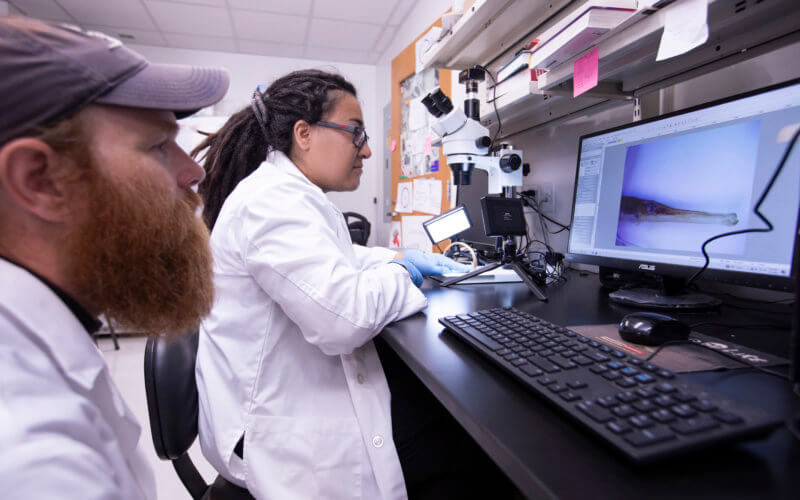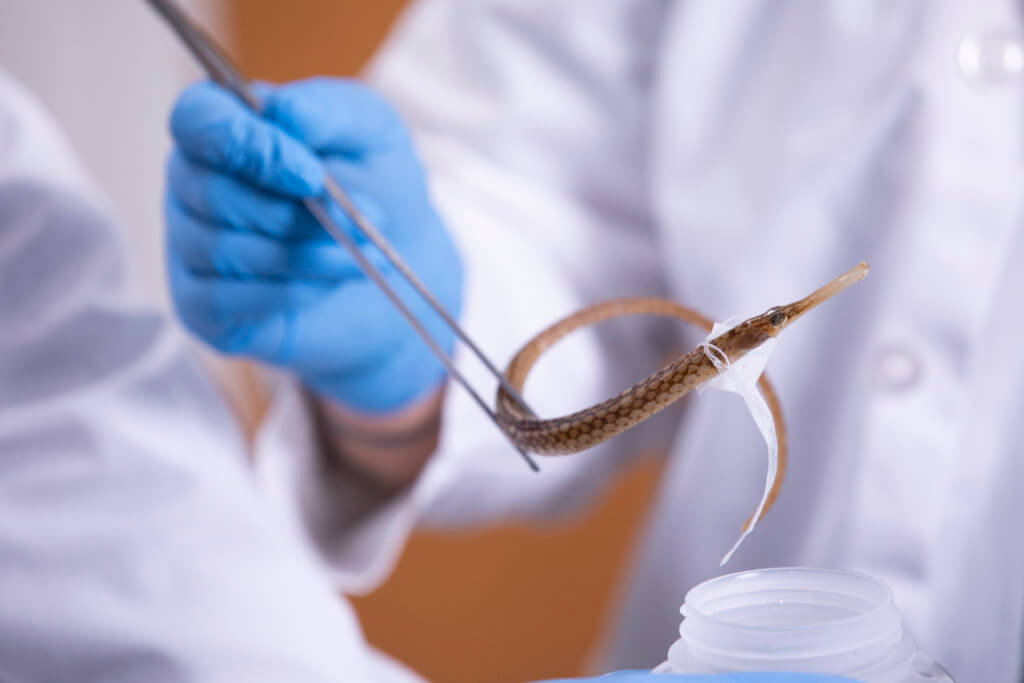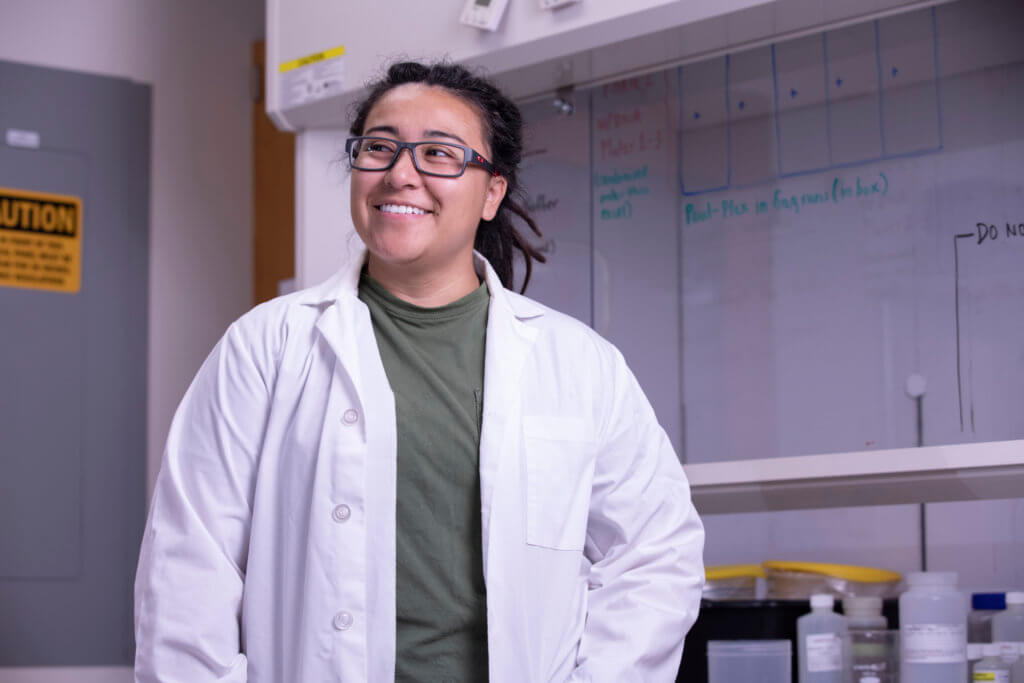
Inside a lab in McCarthy Hall, biology graduate student Anabell Espinosa removes a museum sample of a California pipefish from a glass jar. She then places the specimen under a microscope to examine its head shape.
As she peers into the microscope, she zeros in on the head to determine the relationships between head morphology and the ecology and evolution of these long, thin fishes.
With a face resembling a sea dragon, a snake-like body and a slim snout, five pipefish species were historically reported in the coastal waters of Southern California. Pipefishes, which grow 6 to 8 inches in length, are relatives of the seahorse and sea dragon that live cryptically among seagrasses and seaweed.
A 2019 study published in the Journal of Fish Biology by marine biologists, including Cal StateFullerton biological science professors Douglas J. Eernisse and Kristy L. Forsgren, proposed classifying four of these pipefishes into one species since they have the same genetic makeup and similar characteristics.
Even so, within this newly revised species (Syngnathus californiensis), there appear to be two conspicuous head shapes with different mouth and snout characteristics, said Ryan Walter, associate professor of biological science, Espinosa’s research adviser.

To learn more about these two seemingly different morphologies within this species, Espinosa is characterizing the diversity of head shapes among individuals and looking for links to the environment where these fishes are found.
“Anabell’s thesis research will help to document important morphological variation that likely underlies ecological differences among California’s pipefishes,” Walter said.
Espinosa added that her study would give scientists more information about the species’ morphology differences based on the location these pipefishes inhabit.
“This knowledge will improve our understanding of the evolutionary processes and diversification in pipefishes of the eastern Pacific Ocean,” said Espinosa, who studied pipefish DNA as an undergraduate alongside Walter.
A California State University Council on Ocean Affairs, Science & Technology’s (COAST) Dr. Kenneth H. Coale Graduate Scholar Award and CSUF’s Veterans Student Success Scholarship and Pa’lante Fellowship fund her research project.
For her lab-based work, Espinosa obtained museum specimens from the ichthyological collections at the Natural History Museums of Los Angeles County and UC San Diego Scripps Institution of Oceanography.
Walter said that Espinosa is applying geometric morphometrics, a technique that can reveal subtle but important differences in organisms’ shape and body parts.
“This technique has been used on fish fins and jaws, butterfly wings and mammal skulls to uncover important sources of variation and reveal evolutionary novelty,” he added.
Her research findings reveal that the snout morphology of California pipefish seems to be linked with the location where the fish lives.
“Specifically, northern pipefish populations — San Francisco to Alaska — have a more elongated snout, whereas pipefish from southern locations — Santa Barbara to Baja California — have a wider and shorter snout,” said Espinosa, who presented her research virtually this summer at Evolution 2023, a global research conference.
The differences may be tied to the size of zooplankton, tiny aquatic microorganisms that pipefish eat in their habitats — and the efficiency of their snout types.
“Zooplankton species are more diverse at lower latitudes, with smaller and bigger sizes available. Pipefishes found at southern locations have a wider snout. A wider snout allows pipefishes to feed on various prey sizes,” Espinosa explained.
“My study found that pipefishes from northern populations have a more elongated snout, where zooplankton at higher latitudes tend to be larger.”
Previous studies on feeding behaviors show that pipefishes with more elongated snouts have higher success when catching larger prey than smaller prey, the researchers said.
From Transfer Student to Marine Biology Researcher

Espinosa, a native of Ambato, Ecuador, moved to the U.S. with her mother when she was 18. A first-generation college graduate, she attended Fullerton College and transferred to CSUF, earning a bachelor’s degree in biological science in 2021.
As an undergraduate, balancing her academics and research activities was challenging due to her service in the Army National Guard. She served as a medic for six years and deployed to emergencies, including California’s wildfires and the COVID-19 pandemic. She initially pursued college to become a doctor, but after conducting research with Walter, she changed her mind.
To help her prepare for the next step in her education, Espinosa is a recipient of the California State University’s 2022-23 Sally Casanova Pre-Doctoral Scholarship, which supports underrepresented students with doctoral aspirations.
As a Sally Casanova scholar, she interned at Scripps Institution of Oceanography this summer and learned about artisanal fisheries and their impacts on coastal communities. Unlike commercial fishing, artisanal fisheries involve fishing for individual, family or community consumption.
Espinosa plans to pursue a doctorate after she completes the master’s program in biology in the fall and aspires to a teaching and research career at the university level.
“My research experiences have given me confidence and empowered me to advance my educational goals,” she said. “Studying marine biology is important because the ocean is one of the most exploited yet more vital natural resources.”